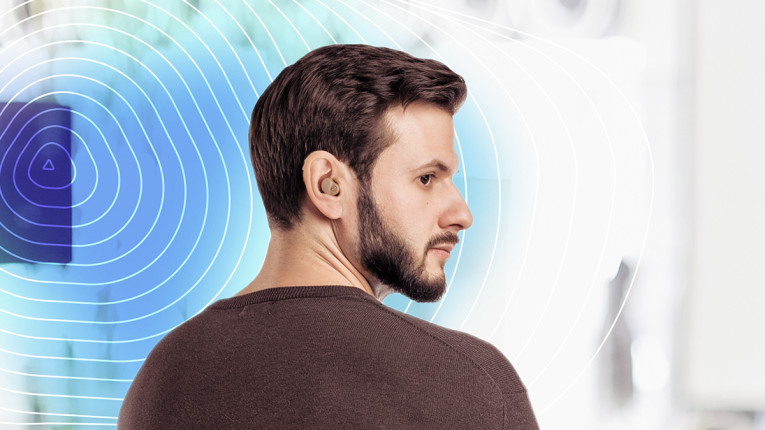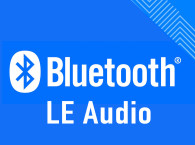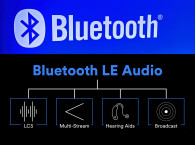
With this announcement, basically the Bluetooth SIG is admiting that after two years of preliminary work until the CES 2022, and after two years of work during the global pandemic, the specifications are still being worked out, and that the audio broadcasting capability based on Bluetooth technology is still "upcoming". While the LC3 codec was available in 2020, the actual details of technical implementation for the new use cases are still being worked out.
As the Bluetooth SIG describes, the new Auracast (which is now a trademark) broadcast audio "technology" that enables an audio transmitter, such as a smartphone, laptop, television, or public address system to broadcast audio to an unlimited number of nearby Bluetooth audio receivers, including speakers, earbuds, or hearing devices.

Basically, this is the same functionality that was available many years ago in the SKAA Wireless Audio proprietary technology developed by Canadian firm Eleven Engineering and today available in numerous products, which receive audio via Wi-Fi or Bluetooth and then transmit using SKAA to multiple receivers.
Other earlier attempts to implement the functionality over Bluetooth have been demonstrated by companies such as Tempow, meanwhile acquired by Google. Their first product, the Tempow Audio Profile (TAP) was an updated Bluetooth protocol allowing any Bluetooth chip to stream audio on multiple Bluetooth audio outputs simultaneously. It was a 100% software solution and worked with any brand of Bluetooth speaker on any chip.
According to Mark Powell, CEO of the Bluetooth SIG, Auracast broadcast audio is the new solution to make this vision a reality, even though the creation of a "technology" and separate trademark seems to imply that its scope falls beyond the scope of the original LE Audio specifications.
"The launch of Auracast broadcast audio will trigger another massive change in the wireless audio market. The ability to broadcast and share audio using Bluetooth technology will reshape personal audio and enable public venues and spaces to deliver audio experiences that will improve visitor satisfaction and increase accessibility,” Mark Powell says.
"Bluetooth technology is extending its track record of innovation with the launch of Auracast broadcast audio," adds Peter Liu, System Architect, Pixel Ecosystem Products at Google. "We are proud to work with the Bluetooth SIG and are excited to see this capability provide consumers with new, imaginative ways to connect with each other and hear their world."

Auracast broadcast audio will be now promoted for the ability to "Share Our Audio", allowing users to invite others to share their audio experience - at the personal level, and "Unmute Our World", for pure broadcast audio applications. Examples long envisioned and already available over Wi-Fi will now be implemented over Bluetooth, such as the ability to enjoy television sound in public spaces. Silent televisions in public venues like airports, gymnasiums, restaurants, and waiting rooms will be able to broadcast audio that any visitor with Auracast enabled Bluetooth earbuds or hearing aids will be able to hear.
Another logical avenue of the technology is the "Hear Our Best" application, where Auracast broadcast audio will support hearing assist when visiting a public venue such as a transit center, cinema, conference center, or house of worship. Visitors to those spaces will be able to receive audio broadcasts from the public address system directly into their Auracast enabled Bluetooth earbuds or hearing device. Travelers at an airport, for instance, will be able to receive essential flight announcements such as gate changes, boarding schedules, and other travel information directly to their personal audio device. When used in this manner, Auracast broadcast audio will function as "the next-generation assistive listening system (ALS) technology," the Bluetooth SIG states.

"While current assistive listening systems, such as inductive loops, have been providing great benefit to people with hearing loss, they suffer from a number of challenges that have limited their deployment, including poor quality, high cost, and lack of privacy," says Nick Hunn, CTO of WiFore. "Auracast broadcast audio is well positioned to become an advanced, new assistive listening system that will be significantly easier and lower cost to deploy while offering higher audio quality and greater privacy, improving audio accessibility and promoting better living through better hearing."
"Hearing and understanding speech in various environments can be a daily struggle for people with any degree of hearing loss," says Barbara Kelley, executive director of the Hearing Loss Association of America. "Audio quality innovations can benefit everyone, while also improving communication access to those with hearing loss. Having choices in technology to meet the varying needs of people with hearing loss is critical. The advent of technologies like Auracast broadcast audio has the potential to give people who wear hearing aids and cochlear implants an important new option for hearing access in their everyday lives."

The Bluetooth specifications that define Auracast broadcast audio are part of the Bluetooth LE Audio specification suite and are expected to be released within "the next few months." Audio product developers and venue operators can learn more about Auracast broadcast audio at www.bluetooth.com/auracast.
Formed in 1998, the Bluetooth SIG is the not-for-profit trade association that oversees Bluetooth technology. In support of more than 38,000 member companies, the Bluetooth SIG facilitates the collaboration of its members to create new and enhanced specifications that expand the technology, drives global interoperability via a world-class product qualification program, and grows the brand by increasing the awareness, understanding, and adoption of Bluetooth technology.
www.bluetooth.com








